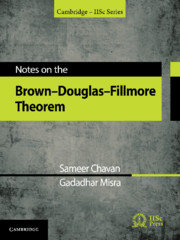Book contents
- Frontmatter
- Dedication
- Contents
- Preface
- From: The Evolution of Modern Analysis, R. G. Douglas
- Overview
- 1 Spectral Theory for Hilbert Space Operators
- 2 Ext(X) as a Semigroup with Identity
- 3 Splitting and the Mayer–Vietoris Sequence
- 4 Determination of Ext(X) as a Group for Planar Sets
- 5 Applications to Operator Theory
- Epilogue
- Appendix A Point Set Topology
- Appendix B Linear Analysis
- Appendix C The Spectral Theorem
- References
- Subject Index
- Index of Symbols
3 - Splitting and the Mayer–Vietoris Sequence
Published online by Cambridge University Press: 30 June 2021
- Frontmatter
- Dedication
- Contents
- Preface
- From: The Evolution of Modern Analysis, R. G. Douglas
- Overview
- 1 Spectral Theory for Hilbert Space Operators
- 2 Ext(X) as a Semigroup with Identity
- 3 Splitting and the Mayer–Vietoris Sequence
- 4 Determination of Ext(X) as a Group for Planar Sets
- 5 Applications to Operator Theory
- Epilogue
- Appendix A Point Set Topology
- Appendix B Linear Analysis
- Appendix C The Spectral Theorem
- References
- Subject Index
- Index of Symbols
Summary
In this chapter, we address the question of decomposing the semigroup Ext(X) provided a decomposition of X is given. In particular, we introduce the notion of splitting of an extension, and note that a closed disjoint cover ﹛A, B﹜ of X yields direct sum decomposition of Ext(X) into Ext(A) and Ext(B). As the first major step in the ultimate splitting lemma (to be proved in the next chapter), we establish the first splitting lemma, which states that such a decomposition holds for a closed cover ﹛A, B﹜ if A ∩ B is a singleton.
Splitting
Let X be a compact Hausdorff space. Given a*-monomorphism and, write Tf for any operator in such that. It will always be understood that Tf is determined only up to simultaneous unitary equivalence modulo the compacts. Recall that Imτ stands for the image of. If T is in and E is an orthogonal projection in, then write TE for the operator in.
Lemma 3.1
Let e be an orthogonal projection in the Calkln algebra and τe : be a *-monomorphism such that τe(1) = e. If E is an orthogonal projection in such that π(E) =e (see Corollary 2.2.1), then we have the following statements:
(1) (Existence) There exists a unital *-monomorphism such that
where and.
(2) (Uniqueness) If F is another orthogonal projection such that π(F) = e, then τe,E is equivalent to τe,F.
Proof (1) Note that implies that, that is,. Thus, the map is well defined. Similarly, one can see that the projection e commutes with, and hence,
If we decompose the operator Tf with respect to E and I − E, then by (3.1.1), the off diagonal entries are compact. Thus, the map is *-homomorphism.
(2) Let F be an orthogonal projection in such that and note that E − F is a compact operator. Let U and V be isometries in such that and are unitaries (see Corollary 1.5.1). Define and by
Since EU and FV are unitaries,
As weakly equivalent extensions are equivalent (see Proposition 2.5.1), it suffices to show that is weakly equivalent to Observe that
In the last but one equality, we have used the fact that E and F differ by a compact operator.
- Type
- Chapter
- Information
- Notes on the Brown-Douglas-Fillmore Theorem , pp. 91 - 116Publisher: Cambridge University PressPrint publication year: 2021



